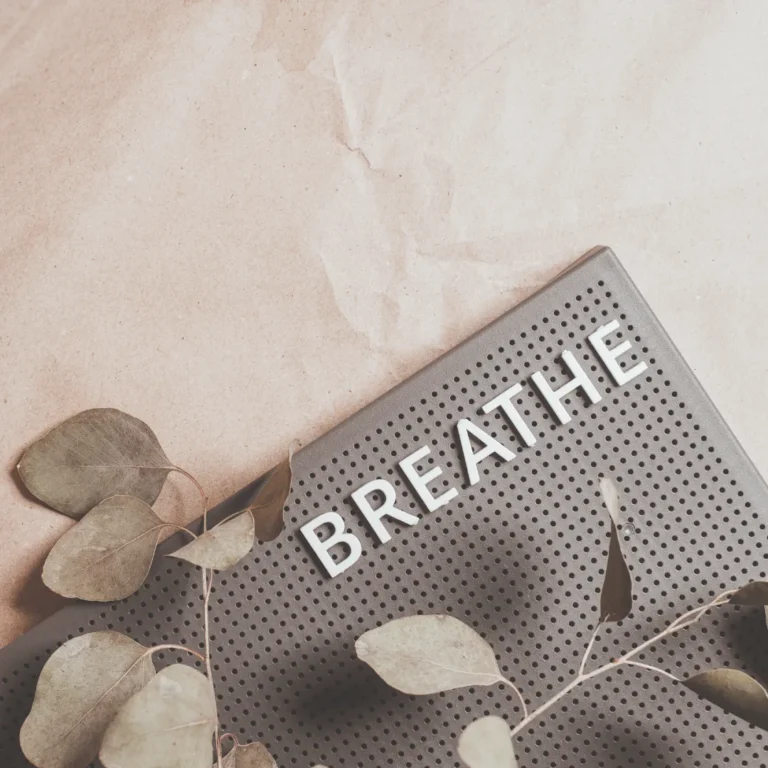Breath and Energy: How Conscious Breathing Fuels Self-Awareness and Vitality
You breathe about 20,000 times a day. But how many of those breaths are actually intentional?
Most of us go about our day with shallow, unconscious breathing. It gets the job done…but barely. If you’ve ever felt foggy, fatigued, or emotionally reactive without knowing why, there’s a good chance your breath (and your energy) is part of the story.
Conscious breathing, also known as breathwork, isn’t just a wellness buzzword. It’s a research-supported tool for recalibrating your nervous system, recharging your energy field, and building something many of us are craving right now: real self-awareness.
Let’s take a closer look at how your breath shapes your energy, your mood, and even your sense of who you are.
So, what’s the connection between breath and energy?
From a physiological perspective, your breath is your most immediate access point to the nervous system. Slow, deep breaths can downregulate stress hormones like cortisol, increase oxygenation to the brain, and help shift the body from fight-or-flight into a state of rest and repair.
From an energetic lens, the breath acts like a bridge connecting the physical body with the biofield, or the subtle energy system that surrounds and interacts with your body. When you breathe consciously, you’re not just getting more oxygen. You’re also helping to clear energetic congestion, regulate emotional flow, and restore balance.
“Breath regulates how we feel, how we think, and how we respond,” says Yale School of Medicine. “It’s not just automatic, it’s powerful.”
Why self-awareness starts with your breath
When you’re stressed or overwhelmed, your breath tightens. You may hold it, breathe from your chest, or forget to exhale completely. Over time, this can leave you feeling disconnected not just from others, but from yourself.
Practicing breath awareness can:
- Increase mental clarity and decision-making
- Help you notice what you’re feeling, instead of just reacting
- Create space between stimulus and response
- Support emotional regulation and resilience
In other words, learning to observe your breath helps you learn to observe yourself, and that’s the foundation of self-awareness.

The science behind it
There’s growing research showing that breathwork can positively impact:
- Brain health: Studies show that breathing techniques increase neuroplasticity and improve executive function
- Nerve signaling: Deep, rhythmic breathing improves vagus nerve activity, which is crucial for calm, rest, and digestion
- Hormonal regulation: Breath affects the endocrine system and has been linked to better cortisol balance
- Mental health: A review in Frontiers in Psychology showed that breath-based practices significantly reduce symptoms of anxiety, depression, and trauma
- Biofield health: Energy-based practices paired with breathwork may enhance vibrational vitality, promoting long-term wellness
Even basic deep breathing(like the kind recommended by the National Cancer Institute and WebMD) has been shown to ease tension and improve focus in minutes.
Easy ways to bring breath into your day
You don’t need to be an expert in pranayama or attend a workshop to start using your breath as a wellness tool. Here are a few science-supported, beginner-friendly options to try:
- Box breathing
Inhale for 4 counts, hold for 4, exhale for 4, and hold again for 4. Repeat for 2 to 5 minutes. Great for calming the mind quickly. - Extended exhale
Breathe in for 4 counts and out for 6 to 8 counts. This activates your parasympathetic nervous system and supports relaxation. - Diaphragmatic (belly) breathing
Place one hand on your chest and one on your belly. Breathe in slowly, letting your belly rise, then exhale fully. This increases oxygen flow and supports energetic grounding. - Get outside
Fresh air matters. It delivers cleaner oxygen, stimulates your senses, and helps regulate CO₂ levels, all of which can support clarity and mood.

When you need a little more support
Sometimes, breathwork on its own isn’t enough. If you’re feeling chronically out of sync, exploring energy-based practices may help you go deeper.
Some people combine conscious breathing with:
- Biofield therapy
- Frequency-based energy sessions
- Mind-body techniques like EFT or sound healing
If you’re curious, there are non-invasive tools available that assess your biofield and help you personalize your wellness practice. These technologies don’t replace the breath, but they can complement it, offering insights into subtle imbalances that might be holding you back.
Final thoughts
You don’t need to climb a mountain or sit in silence for hours to become more self-aware. You just need to start with your breath.
With every slow inhale and intentional exhale, you’re training your body to regulate, your mind to focus, and your energy to align. And in that process, you build the kind of self-awareness that empowers everything else: clarity, purpose, connection, and healing.
So the next time you feel overwhelmed or scattered, pause.
Take one breath.
Then another.
The version of you who knows exactly what to do next is waiting there.
Frequently Asked Questions about Conscious Breathing
1. What’s the difference between conscious breathing and meditation?
While they often overlap, the focus is different. Meditation is a broad practice of training attention and awareness, which can sometimes use the breath as an anchor. Conscious breathing, or breathwork, is the specific practice of actively manipulating the breath (e.g., changing its pace, depth, or rhythm) with the primary goal of shifting your physical, mental, or energetic state.
2. How often should I practice breathwork to feel a difference?
You can feel immediate benefits, like a sense of calm, from just one two-minute session of box breathing. For more lasting changes in stress levels, energy, and self-awareness, consistency is key. Aim for a short 5-10 minute practice daily. The effects are cumulative, building over time.
3. Can you do breathwork wrong? Are there any risks?
For the gentle techniques described in this article (box breathing, extended exhale, diaphragmatic breathing), the risks are extremely low. The most common issue for beginners is feeling slightly lightheaded, which usually resolves by returning to a normal breath. However, more advanced or intense breathwork styles should be learned with a qualified instructor, especially if you have pre-existing respiratory, cardiovascular, or psychological conditions.
4. Why does deep breathing sometimes make me feel dizzy or lightheaded?
This is a common and usually harmless sensation for beginners. It’s often caused by a rapid shift in the oxygen and carbon dioxide levels in your blood. When you suddenly breathe much more deeply than usual, you increase oxygen intake, which can cause temporary lightheadedness. If this happens, simply pause and return to your normal, gentle breathing pattern until the feeling passes.
5. Which breathing exercise is best for stopping anxiety quickly?
For immediate anxiety relief, the Extended Exhale is one of the most effective techniques. By making your exhale longer than your inhale, you strongly activate the parasympathetic nervous system—your body’s “rest and digest” mode. This sends a powerful signal to your brain and body to calm down, often providing a sense of relief in under a minute.

References
- FasterCapital – Energy Healing and Self-Awareness
- PMC – Breath-Based Mindfulness for Wellbeing
- National Cancer Institute – Deep Breathing Definition
- WebMD – How to Deep Breathe
- News Medical – The Science of Breathwork
- PMC – Oxygenation and CO₂ Balance in Breathing
- Yale Medicine – The Power of the Breath
- American Lung Association – Are You Breathing Wrong?
- Wim Hof Method – Energy and Breath
- Lone Star Neurology – Breathing and Brain Function
- Chirohouse – Why Breathing Matters
- St. Mary’s Health – The Benefits of Fresh Air
Disclaimer:
This information is for educational purposes only and does not constitute professional medical advice. Always consult a healthcare professional before incorporating any new therapy into your practice.
Do you want to see all the updates?
👉 Follow us on Instagram and Facebook and never miss a thing!




